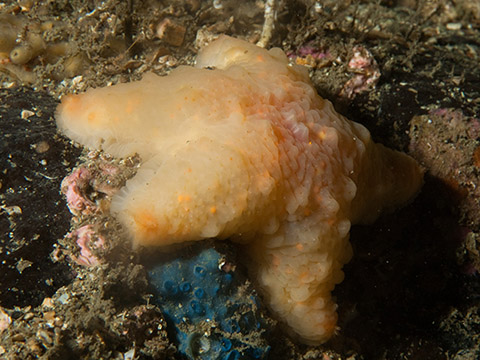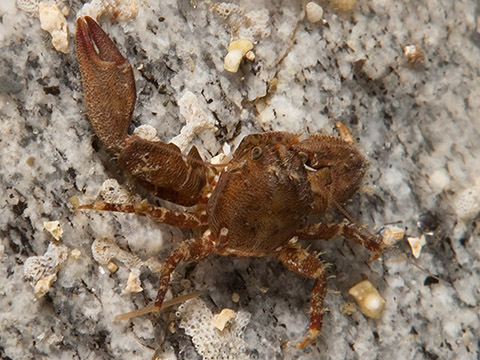
The sea star Pteraster militaris.
It was windy, 0°C and dense snow showers. I love this time of year, because the period from January to April is the top nudibranch season. A large number of different species turn up on diveable depths. They come to mate and spawn, and then most of them die. Only the eggs live until next winter to secure the survival of the species. So, this was a perfect day to visit one of my favorite nudibranch location, called Selva, at the outer region of the Trondheim Fjord. There you will find steep, rocky formations with plenty of hydroids, the favorite food of many nudibranchs.
Following my standard swimming path, at 32 meters I saw a sea star I had never encountered before. I cannot claim it was beautiful. It actually looked severely hit by some skin disease. I later learned that the bumpy skin is a characteristic feature of the Pterasteridae family. There are two similar species, Pteraster pulvillus and P. militaris, and identification is not straightforward. The first does not grow bigger than 4 cm and is recorded on depths from 15 meters. The latter should only be encountered deeper than 100 meters, according to literature. It can reach a diameter of 8,5 cm, though. The sea star I found had a diameter of 6-7 cm, so I think it can only be P. militaris. This sea star obviously had not read the same literature as me, it should not be this shallow.
When I left the sea star, I had spent half an hour at 32 meters depth. There was not any time left to look for nudibranchs, as I had to prioritize a proper depth profile during the ascend, rather then nudibranch hunt. Species no. 349 on seawater.no made the dive worthwhile, anyway. I was a bit cold after 75 minutes of diving, I must admit.
Your dive is just half-done when you step out of the water, my wife tells me. She is right, as always. Looking through the images the following day, I remembered a tiny creature I saw under a rock, towards the end of the dive. It looked like a juvenile crab, the carapace was less than 10 mm wide. Luckily, I took some shots. It turned out to be a long-clawed porcelain crab, the first porcelain crab and species no. 350 to enter seawater.no!
